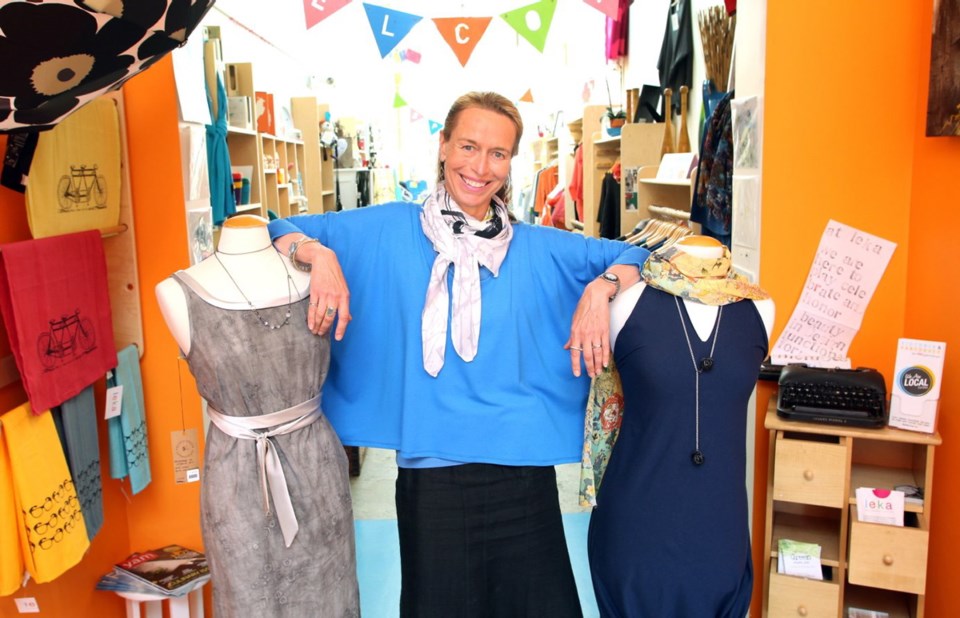Consumers should ask themselves what a bargain really means and what is the true cost of an item of clothing in the wake of the tragedies in Bangladesh garment factories, says Aase Lium-Hall, owner of Victoria’s Leka Clothing.
“It’s accountability and responsibility,” said Lium-Hall, who has three employees sewing in her 2,200-square-foot store at 1044A Fort St.
“We all have financial issues. We all have choices to make,” Lium-Hall said. “I’m making a political decision every time I spend every single dollar.”
Her customers are “thrilled that we are making locally,” she said.
Awareness about where and how clothing is made is at the top of global consciousness following continuing tragedies in Bangladesh. A fire swept through a clothing factory in Dhaka killing eight people on Thursday. Two weeks ago, a garment factory collapsed and the death toll is approaching 1,000. A November fire led to the deaths of 112.
And while there’s universal agreement that building, fire and safety standards need to be improved in many factories in developing countries, the overall issue is complex. Factors include North America’s appetite for cheap clothing and the economic impact that factory work has on impoverished people overseas.
It’s time to redefine what value really means, Lium-Hall said. People should be thinking more about “how is it possible for this [item] to be $5? Where is someone not being compensated, or where is the environment not being compensated?”
Lium-Hall uses bamboo, merino wool and modal (made from beech wood), buying from a Vancouver company. “We are creating fabrics from more renewable resources,” she said.
Her products are long-lasting, she said. Prices include $69 for a long-sleeved bamboo shirt, skirts at $79, and undies at $25.
Retail consultant David Ian Gray, founder of DIG360 in Vancouver, said Bangladesh has struck a nerve in our society. His company has commissioned a cross-Canada poll, with results expected early next week, on how consumers are responding to events in that country.
Wendy Evans, founder of Evans and Co. Consultants in Toronto, agrees that more consumers are looking at labels and thinking about the source of goods.
She said that while some manufacturing can be done in Canada,the reality is the “labour differential and where the actual raw materials come from dictates economics that mean that the goods in all likelihood will be sourced from elsewhere.”
At Victoria’s Hemp and Co., co-owner Bill Finley said customers are talking about the tragedies in Bangladesh. When Hemp started 14 years ago, it decided to use Canadian-produced goods, thinking, “let’s support the people that support us.” Between 25 and 30 per cent of the company’s merchandise is its own brand.
In the past four to five years, young designers have been increasingly turning to natural fabrics as they think about the source of their products, he said.
In the 1950s, the vast majority of clothing was made in Canada, now most of it is imported, Finley said.
Trish Tacoma, owner of Victoria-based Smoking Lily, said customers, “have always appreciated local and knowing who made it.”
Smoking Lily’s clothes are manufactured in Victoria, but Tacoma supports off-shore manufacturing provided that workers receive a living wage and are in a safe environment.
Some big names in Canadian fashion are able to boast about at-home manufacturing for at least some of their products. These include Jacob, a retailer with 100 stores across the country, Stanfield’s underwear of Nova Scotia and Canada Goose.
Montreal-based Jacob produces 25 per cent of its collections in Canada, said Cristelle Basmaji, company spokeswoman.
Jacob’s made-in-Canada collections feature a maple leaf on tags and products, she said. “Many customers actually ask for it because it’s definitely an added value for them.”
Bob Kirke, executive director of the Canadian Apparel Federation, said from Ottawa said people need to decide what is important. “People are paying less and less and less and less every single year for their apparel versus other consumer expenditures,” he said.
Issues around garment manufacturing are complicated. No one denies that Bangladesh has incredible problems, he said. It gets a tariff break on its production, spurring apparel factories which give work to women and in turn result in higher education, health and income.
Kirke urges companies operating in Bangladesh to visit factories themselves to check standards and not just send an agent. He also said it’s worth it to work with good companies and not to jump from one to another to save a couple of cents on producing one item.
Kirke supports the UN’s International Labour Organization efforts to establish its Work Better program in Bangladesh to identity problems, line up international financing and work with brands to fund building improvements.



